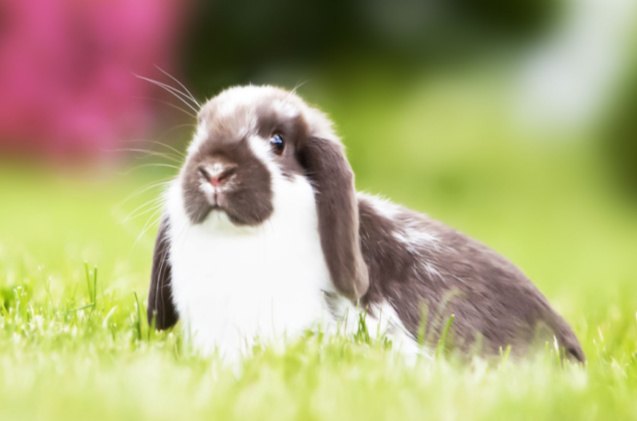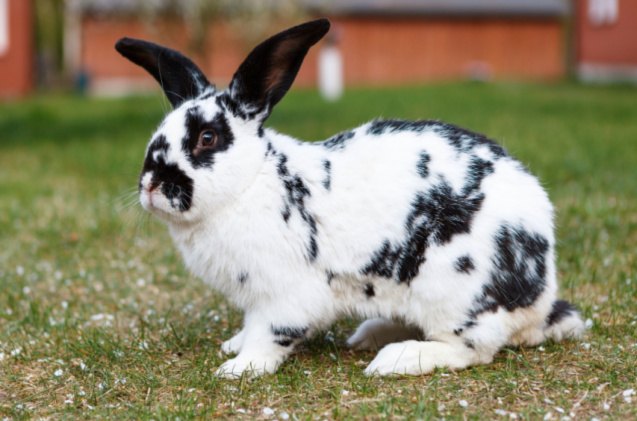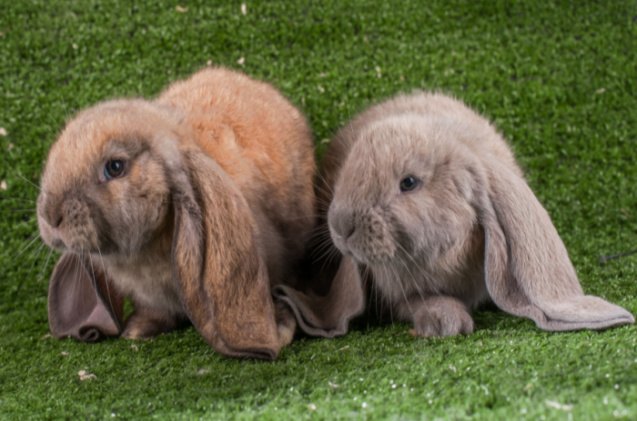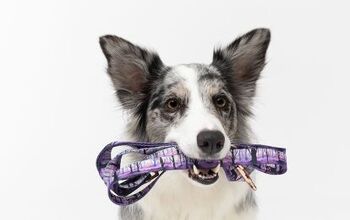Top 10 Best Rabbits for 4H

Participating in 4-H clubs and programs can be an experience that will be cherished for life – especially when a child gains a pet best friend thanks to it. One of many programs that 4-H has is the so-called rabbit project, which is supposed to provide experience with “the selection, feeding, husbandry, and exhibiting of rabbits” to young people. There are various rabbit projects within the 4-H, including breeding, pet, and market projects, but we’ll focus on the best rabbits for 4-H programs that are meant for raising pet rabbits.
While bunnies might seem like an easy animal to care for, that might be misleading – rabbits require care, love, and attention as much as any other pet. Even within 4-H guidelines, it is emphasized that the bunnies that are raised for the project should be well taken care of, or the so-called five freedoms rule: freedom from hunger and thirst, from discomfort, from pain, injury or disease, from fear and distress, and freedom to express normal behavior.
With that being said, the 4-H rabbit program can be an excellent way to introduce your kid to the responsibility of taking care of a pet. What starts off as a project, can become a beautiful friendship – but only if your child is serious about keeping the rabbit and providing them appropriate care.
When it comes to the choice of rabbit breed for 4-H projects, any of the 50 rabbit breeds officially recognized by ARBA are accepted. Here is our choice of the 10 best rabbits for 4-H in terms of ease of care, personality, and showmanship potential.
Top 10 Best Rabbits for 4H
#1 Dutch Rabbit
These small but immensely cute rabbits weigh 3.5 to 5.5 pounds and make great pets as well as show rabbits. The Dutch is distinct for the unusual markings of the coat – white saddle on the back, white blaze on the nose, and a white collar around the neck. These bunnies are smart, relatively friendly, and calm – they are a great first pet and will thrive when provided with proper care. A Dutch rabbit won’t mind being handled and will love being out of their enclosure, experiencing the world by your side, which is perfect if you plan on showing your pet for the 4-H project.
#2 Mini Lop Rabbit
Big floppy ears, cute fluffy fur, and a range of accepted colors and markings which make each bunny unique – what’s not to love about these guys? Weighing 3 to 6 pounds on average, Mini Lop rabbits are suited to families that don’t have space for a big hutch because, even though they’ll need ample space to roam about, competitive to their size, that’s not as much room as you’d expect. These bunnies are known as cuddly, playful, and sweet and will make a great pet and a companion at rabbit shows.
#3 Lionhead Rabbit
As their name suggests, Lionhead rabbits are easy to spot thanks to their wooly, lion-like mane. The mane can be either thin and wispy (“single mane”) or thick and wooly (“double mane”) and can really make a bunny stand out in the crowd at the show. These rabbits are very small, weighing only 2.5 to 3.5 pounds, and will do great in an apartment provided that they have free space to stretch their legs. Thanks to their petite bodies, and playful, energetic personalities, these bunnies are a great choice for beginners.
#4 Mini Rex Rabbit
Popular for its plush coat and lovely temperament, the Mini Rex rabbit will make the sweetest companion and the star of any bunny show. These rabbits weigh 3.5 to 4.5 pounds on average and come in a wide range of accepted colors from all shades of solids to patterned and broken – anyone can find a Mini Rex to fall in love with. They are quiet and calm and tend to get along well with respectful, careful children that know how to properly handle a rabbit.
#5 Netherland Dwarf Rabbit
The tiniest breed on our list is the adorable Netherland Dwarf, which weighs only 1 to 2.5 pounds! Ideal for people that have limited space for keeping a pet (a cage measuring 18 by 24 inches is perfectly fine as long as your bunny gets plenty of time outside of it). While incredibly cute and mild-mannered, Netherland Dwarfs tend to be a bit shy and skittish, so they might not be the best choice for an impatient young kid – but if you put in the effort to get them to trust you, you’ll be rewarded with a sweet, calm companion.
#6 Blanc De Hotot Rabbit
Unique-looking Blanc De Hotot rabbits are easy to recognize thanks to their striking looks – an all-white coat with dark brown, almost black round markings around their eyes that look like they have eyeliner on. Talk about a showstopper! These bunnies are somewhat large at 8 to 11 pounds on average so take their space requirements into account before committing. Blanc De Hotot rabbits have a sweet, friendly personality when socialized on time and make good pets for families of all sizes.
#7 Checkered Giant Rabbit
If you have space to spare and want a big bunny that’s sweet but not too needy, the Checkered Giant is the breed for you. These rabbits weigh 11 to 13 pounds and boast one-of-a-kind markings on their all-white body: blue or black butterfly mark on their nose, two spots on their sides, and a single stripe running across their back. While relatively friendly and docile, Checkered Giants are not clingy as some breeds of rabbits – they don’t mind being handled but won’t seek it out.
#8 Polish Rabbit
An all-around favorite both as a pet and participant at rabbit shows, the Polish rabbit is a dwarf breed with a stellar personality. With their average weight being 2.5 to 3.5 pounds, these bunnies are quite petite and adaptable to various living situations. A cuddly, friendly, and affectionate breed when socialized young, the Polish will enjoy your companionship and won’t mind being handled during the showing. These bunnies are accepted in 6 colors – white with blue eyes, white with red eyes, black, blue, chocolate, and broken pattern.
#9 Californian Rabbit
Originally bred as a commercial rabbit, the Californian became a beloved pet and show rabbit across the years. A large breed that weighs 8 to 10.5 pounds, it is quite easy to spot because of its unusual markings, which are the breed’s trademark: black or near-black markings on their nose, feet, and ears. Also, all Californian rabbits must have pink eyes, which makes these bunnies quite striking! Gentle and docile, these rabbits will make lovely pets and show animals – once socialized, they will surprise you with their curious and affectionate side.
#10 English Lop Rabbit
If you want a rabbit that will steal the show and always be the most interesting participant in a 4-H rabbit project, you can’t go wrong with the beautiful English Lop. Their most recognizable trait is their long, oversized ears that can measure up to 32 inches, making them the breed with the longest ears in the world. On average, the English Lop rabbits weigh 9 to 10.5 pounds so they will need a bit more space to feel comfortable and happy. Calm, mild-mannered, and affectionate, these long-eared bunnies make rewarding companions for families of all shapes and sizes.
What Is the 4-H Rabbit Project?
Widely considered America’s biggest youth development organization, 4-H provides children and teenagers aged 5 to 19 years with fun and educational opportunities. There are various great activities included, from camps to project clubs – and one of the more popular projects with the 4-H is the rabbit project.
The 4-H rabbit project teaches children everything about the fascinating world of bunnies, from how to select and breed rabbits all the way to care, feeding, and much more. There are three types of rabbit projects that are available to participate in – market rabbit project, rabbit breeding project, and pet rabbit project. For the market rabbit project, the focus is on breeds that have been bred for meat production, where the goal is to raise at least one litter of rabbits and showcase at least one of them. In the case of the rabbit breeding project, the participants are taught the basics of selecting and breeding rabbits for their desirable traits, but this will also involve culling, which is something to have in mind when considering projects.
Last but not least is the pet rabbit project, which in our opinion, is the best option for any child as it provides a way for a kid to learn everything about the responsibility of caring for rabbits and get to enjoy the companionship these animals provide without the downsides that come with the breeding or market project. The pet rabbit will have to be shown and the kid will have to keep a track record of everything they do for their bunny and all of the things they’ve learned in the process.
How to Choose a Rabbit for the 4-H Rabbit Project
Since the rabbit (or rabbits) that have been chosen for the 4-H rabbit project will have to be shown, the breed you pick has to be officially recognized by the ARBA – or, in other words, a purebred rabbit. There are 50 breeds that ARBA recognizes as such, so there’s plenty to choose from, regardless of which of the three projects is picked. As the rabbit has to be purebred, you will have to obtain one from a breeder to ensure they can be shown in a competition.
If you’re choosing a rabbit for the market rabbit project, you need to pick a breed that has been raised for meat production, such as New Zealand rabbit, Champagne D’Argent, Silver Fox, etc. The goal of the project is to learn the specifics of caring for such types of rabbits and keep a track record of the activities, with the final assignment being showing one (or more) of your rabbits at a show.
The pet rabbit project only requires the rabbit to be recognized by ARBA, but it can be any of the 50 breeds you like. Whether you prefer large breed rabbits that love spending time outdoors or dwarf bunnies that can adapt well to living in an apartment – it’s all the same. The requirements are to care for the rabbit’s health and wellbeing and raise a healthy, happy bunny that will be shown when the project is finished.
For those that opt for the breeding project, the choice of breed is not the only consideration – their rabbit(s) has to adhere to the Standard of Perfection as well. They will be raising a show rabbit that has to have meticulous looks, to be posed and shown in certain ways, and know how to select kits that will display those desired qualities, too. In some ways, this type of rabbit project is the most demanding of all.
It is important to note that, while the basics of the 4-H rabbit project are the same in any state, there are certain variations from state to state. Before you decide on doing a rabbit project, it’s best to thoroughly inform yourself on the specifics and commit to it only if you are fully prepared to provide the best possible care for the rabbit. Even though projects such as this are fun and educational, the final goal should be to ensure the wellbeing of the animal you care for, so don’t take this lightly. You should only do this project if you are ready to commit to owning a rabbit and providing them the best possible care – for the next couple of years of their life.

A proud mama to seven dogs and ten cats, Angela spends her days writing for her fellow pet parents and pampering her furballs, all of whom are rescues. When she's not gushing over her adorable cats or playing with her dogs, she can be found curled up with a good fantasy book.
More by Angela Vuckovic
































